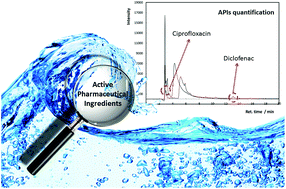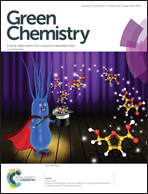Improved monitoring of aqueous samples by the preconcentration of active pharmaceutical ingredients using ionic-liquid-based systems†
Abstract
Fluoroquinolones (FQs) and Non-Steroidal Anti-Inflammatory Drugs (NSAIDs) are two classes of Active Pharmaceutical Ingredients (APIs) in widespread use in human healthcare and as veterinary drugs, and that have been found throughout the water cycle in the past years. These two classes of APIs are commonly present in aqueous streams in concentrations ranging from ng L−1 to μg L−1. Despite such low concentrations, these contaminants tend to bioaccumulate, leading to serious environmental and health issues after chronic exposure. The low concentrations of FQs and NSAIDs in aqueous media also render difficult identification and quantification, which may result in an inefficient evaluation of their environmental impact and persistence. Therefore, the development of alternative pre-treatment techniques for their extraction and preconcentration from aqueous samples is a crucial requirement. In this work, liquid–liquid systems, namely ionic-liquid-based aqueous biphasic systems (IL-based ABS), were tested as simultaneous extraction and preconcentration platforms for FQs and NSAIDs. ABS composed of imidazolium-, ammonium- and phosphonium-based ILs and a citrate-based salt (C6H5K3O7) were evaluated for the single-step extraction and enrichment of three FQs (ciprofloxacin, enrofloxacin and norfloxacin) and three NSAIDs (diclofenac, naproxen and ketoprofen) from aqueous samples. Outstanding one-step extraction efficiencies of APIs close to 100% were obtained. Furthermore, the preconcentration factors of both FQs and NSAIDs were optimized by an appropriate manipulation of the phase-forming components compositions to tailor the volumes of the coexisting phases. Preconcentration factors of 1000-fold of both FQS and NSAIDs were obtained in a single-step process, without reaching the saturation of the IL-rich phase. The preconcentration of APIs up to mg L−1 allowed their easy and straightforward identification and quantification by a High-Performance Liquid Chromatography (HPLC) system coupled to an UV detector, as shown for both model systems (distilled water) and real effluent samples from a wastewater treatment plant.



 Please wait while we load your content...
Please wait while we load your content...